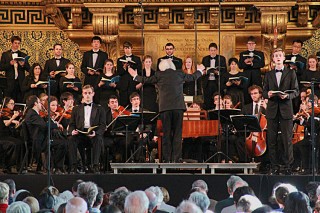Title

The April performances of Bach’s B-Minor Mass mark the third year of Historical Performance’s collaboration with the Yale Schola Cantorum. Last year, the two groups performed Haydn’s Creation in several venues including Yale’s Woolsey Hall (pictured). Masaki Suzuki, a member of the Yale faculty will again conduct the musicians at this year’s performances.
(Photo by Mike Franzman)Graduate study in historical performance is meant, so I’m told, to train students to place music in its historical context—its time and place as well as the practices of performance that are particular to them. On the whole, that’s a pretty fair description of how I’ve spent my years at Juilliard as a Baroque violin student. Sometimes, though, I think what’s really happening is that I’m learning to understand, recognize, and embrace my inner Romantic. “Wait a second,” a voice says. “I’ve heard people talk about ‘Romantic Bach’ versus ‘period Bach,’ and you’re definitely on the ‘period’ side. What are you talking about?”
Body
My imaginary friend’s confusion is justified. I use a short and pointy Baroque bow and a gut-strung violin with no chin rest, and I use rather less vibrato than the average Juilliard violinist. Nevertheless, when it comes to Bach’s greatest works, I am beholden to a basically 19th-century perspective. Few accounts of Bach’s music from his own time sound as much like today’s as does Hans Georg Nägeli’s 1818 advertisement of his forthcoming publication of the Mass in B Minor: “Announcement of the Greatest Artwork of All Times and All People.” This assessment, which in its superlatives favors monumentality and grandiosity, is the same sort of perspective we bring to bear today, the sort of perspective that leads to my writing this article.
What I’m talking about is what promises to be the culminating event of my cohort’s time in the Historical Performance program at Juilliard: two tours with the Mass in B Minor with Masaaki Suzuki conducting Juilliard415 and the Yale Schola Cantorum. The first, in late April, takes us to three locations on the East Coast; the other, in June, to Japan and Singapore. These tours represent a marvelous opportunity not only to perform widely with cherished colleagues and an A-list conductor, but also to come to know Bach’s masterwork more deeply.
The B-Minor Mass is beautiful, to say the least, but challenging to come to terms with. It is, first of all, long: 130-odd minutes (that’s like performing Mahler’s First and Second Symphonies back to back) and fragmented into 27 sections. Plus, if one hears a lot of masses sung in Latin, the text poses a dilemma: the words are so familiar that you may not even realize that you don’t know exactly what they mean. The spiritual content of the B-Minor Mass creates another couple of levels of remove from the present-day performer. All of Bach’s sacred works require some legwork on the part of the musicians to understand the meaning of the text in terms of the theology of Bach’s day and its place in the liturgical calendar. This, a Catholic mass by a devout Lutheran, is particularly puzzling because its significance for its creator can only be guessed at; lacking a specific liturgical context, this is a work that aspires to universality.
Most problematically of all for any claims we might make of historicism, the B-Minor Mass really isn’t one piece at all. It’s a compilation, a synopsis of Bach’s compositional achievement, and a guarantor of his legacy—but it was probably never performed in Bach’s lifetime, and most of its component parts are drawn from other works, written piecemeal over the course of decades. Therefore the performer today faces challenges from this work that Bach and his contemporaries likely never had to. Physical stamina and concentration become a big part of the performer’s experience of this piece. Vocal forces, always a contentious question in Bach’s music, are particularly problematic in this case. Even if you accept, as I do, Joshua Rifkin’s theory that Bach’s chorus generally consisted of one singer per part, how does that apply to a work that was not written for his own ensemble and of which no contemporary performances are documented? And does the exceptionally taxing nature of the writing constitute a reason to expand on his ordinary forces, to ease pressures on any one singer?
There are no firm answers to these questions. However, the opportunity to perform the work multiple times, in three North American and four Asian cities (and this is less than a year after a few of my classmates and I played it twice at the American Bach Soloists Academy in San Francisco last summer) will surely bring all of us lucky enough to participate closer to the work. Familiarity from the inside will, I hope, shed light on some of these issues, and carrying it to one new context after another might clarify something of the nature of its profound impact.




